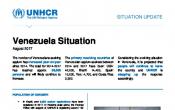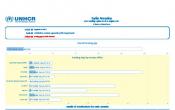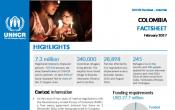Colombia
Operation: Colombia
Location
{"longitude":-73,"latitude":4,"zoom_level":0}
Latest update of camps and office locations 21 Nov 2016. By clicking on the icons on the map, additional information is displayed.
Key Figures
| 2016 end-year results | |
| 200,200 | people were assisted with civil registration or documetation, including som e9,500 children under 12 months who receved burth certificates |
| 16,750 | displaced people received legal assistance |
| 34 | peaceful co-existence projects were implemented for IDPs |
| 2017 planning figures | |
| 88% | of the Colombian legal framework will be consistent with international standards relating to refugees |
| 60% | of communities prioritized by UNHCR will be profiled on their needs to achieve durable solutions using a rights-based approach |
| 50% | of participants in leadership/management structures will be female |
| 85 | refugee and asylum-seeker households will receive cash grants |
| 50 | projects aiming to benefit local and displaced communities alike will be implemented |
| 40 | solutions-related projects will benefit both displaced and host communities |
Latest Updates
People of Concern
7%
Increase in
2016
2016
| 2016 | 7,411,675 |
| 2015 | 6,941,212 |
| 2014 | 6,044,552 |

[["Refugees",258],["Asylum-seekers",386],["IDPs",7410816],["Returned refugees",204],["Stateless",11]]
Loading ...
Colombia
< Back
2016
{"categories":[2012,2013,2014,2015,2016,2017],"budget":[29.39275787,29.63863097,30.54009716,31.64999552,31.48831469,28.68641457],"expenditure":[17.97013045,19.72971212,18.22635741,15.30149255,14.34249313,null]}
{"categories":[2012,2013,2014,2015,2016,2017],"p1":[1.03953852,1.25005017,1.36255488,1.28923061,0.97474715,1.81814932],"p2":[null,null,null,null,null,null],"p3":[null,null,null,null,null,null],"p4":[28.35321935,28.3885808,29.17754228,30.36076491,30.51356754,26.86826525]}
{"categories":[2012,2013,2014,2015,2016,2017],"p1":[0.88555543,0.85886962,0.71250308,0.65932352,0.57263632,null],"p2":[null,null,null,null,null,null],"p3":[null,null,null,null,null,null],"p4":[17.08457502,18.8708425,17.51385433,14.64216903,13.76985681,null]}
Loading ...
CHOOSE A YEAR
- 2014
- 2015
- 2016
- 2017
Working environment
The Colombian Government and the Revolutionary Armed Forces of Colombia (FARC) signed a peace agreement in November 2016 after four years of negotiations. The agreement specifically mentions UNHCR as one of the agencies expected to contribute to its implementation in the area of victims’ rights. A United Nations Special Political Mission is currently monitoring the demobilization and disarmament process.Despite progress towards peace, violence and forced displacement continued in some regions, mainly due to the presence of other illegal armed actors attempting to broaden their territorial control after FARC’s withdrawal.
In addition, the deteriorating situation in Venezuela resulted in a growing number of arrivals in mixed movements, including Colombian returnees and people in need of international protection.
Population trends
- More than 7,083,000 registered internally displaced people (IDPs), displaced since 1985. New displacement has reduced considerably in recent years; some 67,880 people were registered as newly displaced in 2016, although registration and verification continues.
- 258 refugees are registered in Colombia, with nearly half from Cuba and Venezuela. 32 people were recognized as refugees during the year.
- The number of asylum-seekers increased, with 314 new claims in 2016. Venezuelans was the top nationality seeking asylum.
- Voluntary repatriation increased, with some 90 Colombian refugees returning with UNHCR assistance from Venezuela (86) and Ecuador (6). At least 83 other Colombians returned spontaneously.
- Colombia has no significant stateless population at risk, 1 stateless person was granted nationality in 2016.
Achievements and impact
- UNHCR advocated for the protection of IDPs and the prevention of new displacement by intervening in more than 170 communities across 14 departments. Interventions included: the deployment of 11 ombudspersons to isolated areas to help identify the humanitarian situation and protection needs of displaced populations; the implementation of 48 community-based infrastructure projects and 41 community empowerment projects benefiting over 18,000 IDPs and host communities; and capacity building for some 190 community organizations and structures.
- Technical assistance was provided to 151 public institutions on IDP protection, prevention of new displacement, and improving IDPs’ access to durable solutions.
- UNHCR drafted a strategy for legalizing informal IDP settlements, established an inter-institutional working group on informal settlements with governmental and other partners, and supported 19 ongoing settlement legalization processes in seven departments, which will benefit some 26,500 people.
- UNHCR and UNDP consolidated lessons learned and public policy recommendations from the jointly implemented Transitional Solutions Initiative (2012-15), which were shared with the Government and donor community in early 2017
- UNHCR advocated for the inclusion of durable solutions for displaced people as a priority in the period following the peace agreement.
- UNHCR led the development of an inter-agency contingency plan for the Venezuela situation and strengthened protection networks along the border, including through provision of training on refugee law for government officials and partners.
- UNHCR provided cash-based assistance to 87 very vulnerable asylum-seekers and refugees to help meet their basic needs.
Unmet needs
- Due to limited resources, it was not possible to advance in the legalization of informal settlements with a high concentration of IDPs beyond the prioritized 19 ongoing cases
- Resource constraints also limited UNHCR’s capacity to ensure border monitoring and follow-up of returns, both of Colombian refugees from abroad and of Colombian IDPs to their areas of origin.
While the conflict between the Government of Colombia and the Revolutionary Armed Forces of Colombia (FARC) intensified in the first half of 2015, negotiations have continued in Havana between the parties to conclude a peace settlement. Agreement was reached on the establishment of a Truth, Coexistence and Non-Repetition Commission and renewed efforts have been made to secure a ceasefire. UNHCR has given direct support to the negotiators on the restoration of victims’ rights affecting internally displaced persons (IDPs) populations and some 360,000 Colombian refugees. UNHCR also provides technical support to assist the Government in implementing comprehensive protection solutions to displacement, including emergency response.
Conflict and violence continue to generate displacement. In the first half of 2015, 2,020 families were newly displaced. Hundreds of Colombians continue to enter Ecuador each month, most of them fleeing violence in the southern areas of the country. The Bolivarian Republic of Venezuela had also been a destination for asylum-seekers; however, movements stopped in 21 August 2015, following the declaration of a state of emergency by the Bolivarian Republic of Venezuela along the border with Colombia and the closure of the the border.
UNHCR provides assistance to the Colombian authorities with the design and evaluation of public policies and strategies for IDP and refugee returnee protection. It is also handing over to the authorities tested solutions methodologies and lessons learned related to local integration, relocation and return carried out in 17 communities as part of the Transitional Solutions Initiative (TSI). Implemented jointly with UNDP, the TSI seeks to bring about sustainable protection, early recovery and development solutions.
Half of the displaced population in Colombia is subject to displacement to between and within urban centres, aggravated by non-state armed actors.




